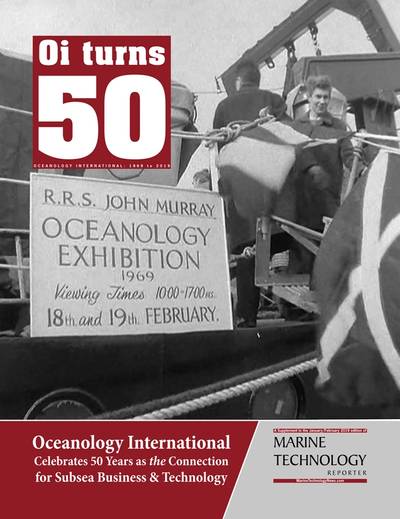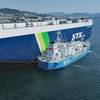Oi: Tracking 50 Years of Ocean Innovation
As Oceanology International celebrates its 50th Anniversary, Marine Technology Reporter explores half a century of subsea technology development and discovery. Oceanology International Americas runs February 25-27, 2019 in San Diego.
When Oceanology launched in 1969 in the seaside resort of Brighton the world was a very different place. For a start, Brighton was home to the mods and rockers, who would square off against each other on the town’s elegant seafront. The British currency included shillings and ha’ pennies and man had yet to step foot on the moon.
More crucially, to the emergent underwater oceanographic and hydronautical world, the excitement that had been building over the past decade about what exploration of the deep could offer, through the likes of Jacques Cousteau, was starting to be applied in a new industry, North Sea oil and gas exploration. The possibilities of new industries such as deepsea mining and seafloor habitation were also being discussed.
Mid-century saw the first gas discovery in the North Sea, followed, a year later, in 1966, by the founding of the Society of Underwater Technology. An industry was born. Just three years later, so was Oceanology. Donald Brooks, of BPS Exhibitions, was its founder, launching the show at the Hotel Metropole on Brighton seafront – a multi-storey pile which had been revamped in the early 1960s to include an exhibition hall and a casino, the UK’s first.
The first show attracted some 600 people, exhibitors and visitors, including British Labour politician and Minister for Technology, Tony Benn (pictured right opening the inaugural evel). Among the show’s first visitors was Marty Klein, who was instrumental in bringing side scan sonar technology to commercial market. “There was a lot of excitement about the oceans,” he says. “Cities under the sea were going to feed the world. People were building manned submersibles to go exploring in the deep. Aerospace companies were building submersibles, like Lockheed, North American, Rockwell and Westinghouse.”
A lot had happened in the years before, recalls Kevin Hardy, who worked at Scripps Institution of Oceanography from 1972 to 2012, from the invention of pingers and even o-rings – a small component perhaps, but one that brought a break-though by improving seal reliability. The French invention and commercialization of the Aqua-Lung had provided scientists unprecedented access to their submerged subjects and the U.S. navy, following World War II, was investing in oceanography.
“The U.S. Navy had funded most of the early ROV technology development in the 1960s including what was then named a ‘Cable-Controlled Underwater Recovery Vehicle’ (CURV),” recalls Jack Jaegar, who worked at Hydro Products and was a leading light in the Marine Technology Society. “This created the capability to perform deep-sea rescue operation and recover objects from the ocean floor.” The U.S. Office of Naval Research’s Floating Instrument Platform (FLIP) became famous at the time and the SEALAB II underwater habitat was in operation off the coast of California.
At the same time, Loran-C was still being used for navigation – there was still plenty of room for improvement. “The Mallory Mercury cell batteries of the early 1970s were bigger than a 16-ounce can of soda, and heavy. If they over-discharged, they split open and liquid mercury came oozing out,” says Hardy.
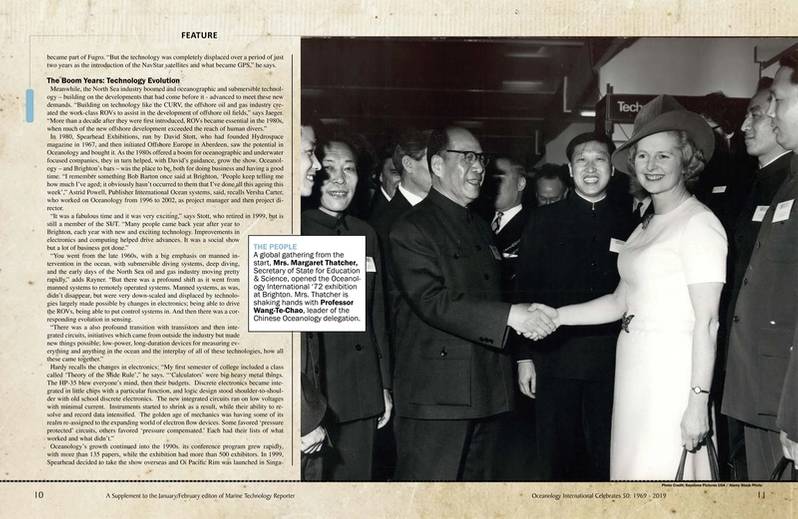 The global draw of the Oceanology International exhibition was apparent from the start. Image: MTR
The global draw of the Oceanology International exhibition was apparent from the start. Image: MTR
At the first Oceanology, there were many people keen to be involved in that improvement and who had just started their own companies, like Ed Curley, who founded EPC Labs, having worked at EG&G (like Klein, who left to form Klein Maritime Industries), recalls Klein. They were on the edge of what would be a boom: North Sea oil had been discovered that same year, following the gas discovery of 1965. “I and others were helping to map the sea bottom for rigs and pipelines, while, in the background, providing equipment for defence and ship building, etc.,” says Klein.
The development of electronic and a new global positioning system (GPS) would spur them on. Indeed, the advent GPS revolutionized navigation. While rudimentary at the time, compared with to, it was an eye-opener for those who got to try it out. “I recall our first sat-nav system, with black punch tape that fed out of one machine to be hand fed into the next,” says Hardy. “We felt part of the Space Age, knowing a satellite in orbit was communicating directly to us while we were over the horizon from land.”
For others, the transition wasn’t so easy. At Wimpey, the focus was on navigation using radio-based positioning. Its technology was in all the major oil and gas fields, says Ralph Rayner, the current event’s chairman, who has been attending Oceanology since 1983, back then as a visitor and since exhibiting with Wimpey Laboratories, then Wimpol, before it became part of Fugro. “But the technology was completely displaced over a period of just two years as the introduction of the NavStar satellites and what became GPS,” he says.
The Boom Years: Technology Evolution
Meanwhile, the North Sea industry boomed and oceanographic and submersible technology – building on the developments that had come before it - advanced to meet these new demands. “Building on technology like the CURV, the offshore oil and gas industry created the work-class ROVs to assist in the development of offshore oil fields,” says Jaeger. “More than a decade after they were first introduced, ROVs became essential in the 1980s, when much of the new offshore development exceeded the reach of human divers.”
In 1980, Spearhead Exhibitions, run by David Stott, who had founded Hydrospace magazine in 1967, and then initiated Offshore Europe in Aberdeen, saw the potential in Oceanology and bought it. As the 1980s offered a boom for oceanographic and underwater focused companies, they in turn helped, with David’s guidance, grow the show. Oceanology – and Brighton’s bars – was the place to be, both for doing business and having a good time. “I remember something Bob Barton once said at Brighton, ‘People keep telling me how much I’ve aged; it obviously hasn’t occurred to them that I’ve done all this ageing this week’,” Astrid Powell, Publisher International Ocean systems, said, recalls Versha Carter, who worked on Oceanology from 1996 to 2002, as project manager and then project director.
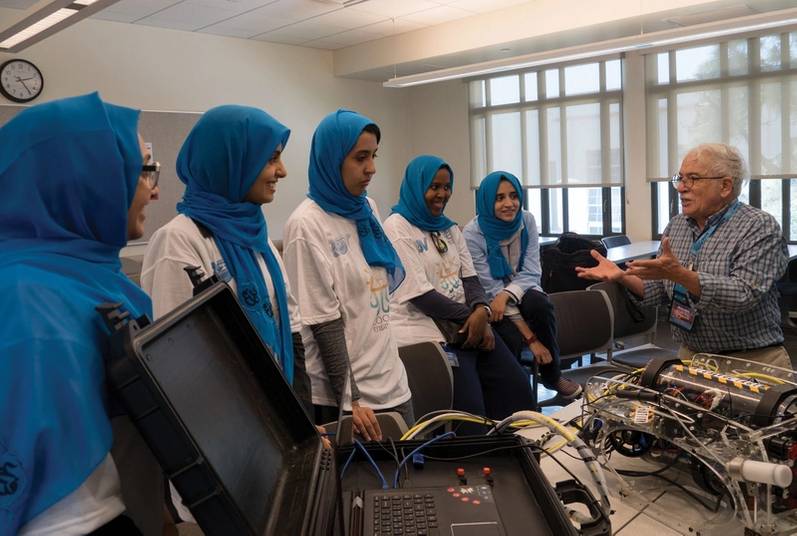 THE PIONEERS
THE PIONEERS
Side scan sonar inventor Marty Klein (right) is an industry icon, involved in the industry events then and now. Pictured here Klein speaks to the all-female ROV team from Saudi Arabia during the 2017 MATE international event. Photo: MATE II
“It was a fabulous time and it was very exciting,” says Stott, who retired in 1999, but is still a member of the SUT. “Many people came back year after year to Brighton, each year with new and exciting technology. Improvements in electronics and computing helped drive advances. It was a social show but a lot of business got done.”
“You went from the late 1960s, with a big emphasis on manned intervention in the ocean, with submersible diving systems, deep diving, and the early days of the North Sea oil and gas industry moving pretty rapidly,” adds Rayner. “But there was a profound shift as it went from manned systems to remotely operated systems. Manned systems, as was, didn’t disappear, but were very down-scaled and displaced by technologies largely made possible by changes in electronics; being able to drive the ROVs, being able to put control systems in. And then there was a corresponding evolution in sensing.
“There was a also profound transition with transistors and then integrated circuits, initiatives which came from outside the industry but made new things possible; low-power, long-duration devices for measuring everything and anything in the ocean and the interplay of all of these technologies, how all these came together.”
Hardy recalls the changes in electronics: “My first semester of college included a class called ‘Theory of the Slide Rule’,” he says. “‘Calculators’ were big heavy metal things. The HP-35 blew everyone’s mind, then their budgets. Discrete electronics became integrated in little chips with a particular function, and logic design stood shoulder-to-shoulder with old school discrete electronics. The new integrated circuits ran on low voltages with minimal current. Instruments started to shrink as a result, while their ability to resolve and record data intensified. The golden age of mechanics was having some of its realm re-assigned to the expanding world of electron flow devices. Some favored ‘pressure protected’ circuits, others favored ‘pressure compensated.’ Each had their lists of what worked and what didn’t.”
Oceanology’s growth continued into the 1990s. its conference program grew rapidly, with more than 135 papers, while the exhibition had more than 500 exhibitors. In 1999, Spearhead decided to take the show overseas and Oi Pacific Rim was launched in Singapore, and run again in 2001, but then dropped. In 2001, Oi America was also launched, with one show in Miami and then another in New Orleans in 2003 (when a New Orleans funeral march band was commissioned to walk through the show halls …), before being dropped. Despite the lack of success at these shows, for Carter, the experience meant meeting and working closely with Don Walsh, one of the few to have visited the depths of the Mariana Trench, alongside Jacques Piccard, and then U.S. Navy Oceanographer, and later Chief Scientist at the U.S. National Oceanic and Atmospheric Administration, Rick Spinrad.
Ocean science has also continued to develop and expand. There have been improvements in ocean sensing – including how much data is being collecting, the quality of it and then what can be done with it through computer modelling. Jaeger highlights the developments in salinity and sound speed measurements, initially mostly done through analogue servo-systems or analogue signal conditioning and data transmission, primarily deployed from surface vessels. EXpendable BathyThermographs (XBTs) have since emerged and global broad scale data is also being collected through Argo floats, he says. Instead of being reliant on dedicated research ships, vessels of opportunity were starting to be used and new platforms developed, such as towed or autonomous vehicles.
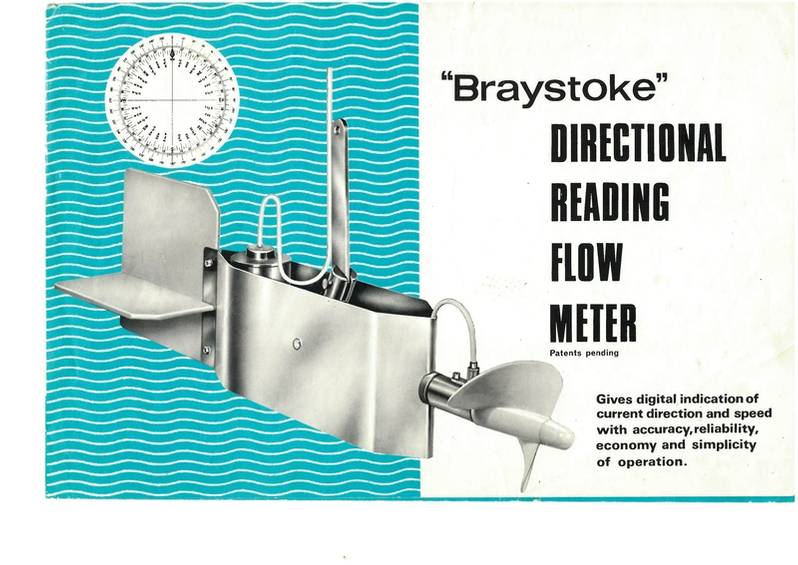 Vintage Valeport – an example of the early Braystoke Impeller brochure. Valeport is also celebrating its 50th anniversary in 2019.
Vintage Valeport – an example of the early Braystoke Impeller brochure. Valeport is also celebrating its 50th anniversary in 2019.
New materials have also made their impact. “Engineering materials, especially plastics, have made wonderful advances,” says Hardy. “PEEK, fiberglass, delrin, and a host of others became as common in the Scripps machine shop as the marine-grade aluminums. Synthetic ropes, from nylon and polypro, to Kevlar and Spectra, have made working at sea a bit kinder.”
In 2000, Oceanology brought in 6,146 visitors and 600 exhibiting companies. But, while the social side of Oceanology was still booming, the conference space was no longer suitable for the amount of visitors the show was drawing in. In 2002, a major decision was made; to move Oceanology from Brighton.
“It was a really difficult move,” says Carter. “People didn’t call it Oceanology, they called it ‘the Brighton show’.” But, while those who had good exhibition spaces were happy with staying in Brighton, there were many who got lost in the “rabbit warren” of the Metropole exhibition spaces. The Metropole, having been keen to develop its conference business in the 1960s, was now less interested and the space was becoming dated. Meanwhile, a new venue was being built – the EXCEL Centre in London – complete with its own quayside, so that vessels could be on site, as part of the show.
A loss was the social scene Brighton offered. While the Beer on the Pier event only ran for a few years, it had quickly become hugely popular with, one year, someone making an oversized copy of the limited entry tickets and writing X 10 on it in a bid to get more people in. “It was traumatic for many at the time,” says Carter. “Many had been going to the same bars and restaurants for years and years, but it was for emotional reasons that they wanted to stay. The bar at the Metropole would be busy with everyone until the early hours. It was a special place.” A strong community of characters had developed there, many of whom attended every event. “It was a relatively small community at the beginning, it was possible to pretty much know everyone, and those characters have been with it, some for the full 50 years,” says Rayner.
After helping the show move to London, Carter left. But she has many fond memories, including meeting the likes of Walter Monk and Sylvia Earle. “I met so many people over the years with so much passion, many just starting their companies with an idea and managing to get to the show and then seeing their idea skyrocket. They owed their success to the show,” she says.
The show continued for Rayner, however, who became show chairman in 2002, and has been heavily involved ever since. “There have been a lot of technology changes and we are going through a bunch more now,” he says. In some cases, technology has changed so dramatically it’s completely superseded what went before. “There have been a few real places markers, like the first self-contained recording instruments and the first real global scale programs for using those, principally the Argo program,” he says. “These in-situ observations have also now become integrated with global satellite observation systems, further advancing how the oceans can be observed.”
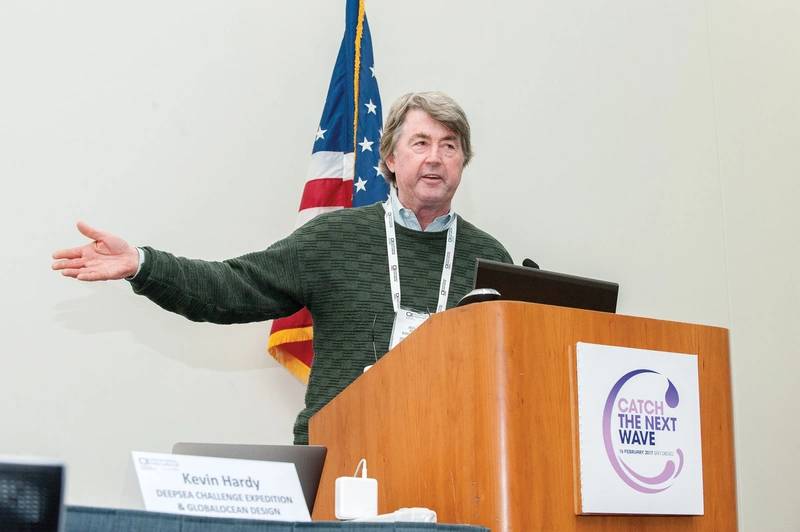 “My first semester of college included a class called ‘ Theory of the Slide Rule’. Calculators’ were big heavy metal things. The HP-35 blew everyone’s mind, then their budgets." -- Kevin Hardy. Photo courtesy Oceanology International
“My first semester of college included a class called ‘ Theory of the Slide Rule’. Calculators’ were big heavy metal things. The HP-35 blew everyone’s mind, then their budgets." -- Kevin Hardy. Photo courtesy Oceanology International
Oceanology International Evolves, too
Two years after moving to EXCEL, Spearhead sold Oceanology to Reed Exhibitions, a move that would see the event expand and internationalize. Into the 2010s, the show once again started going international. Oceanology in London saw 7,728 attendees from 70 countries in 2012. In 2013, Oceanology International launched OI China in Shanghai. London continued to grow, with more than 8,000 visitors in 2014, and in 2017, Oceanology International North America (now called Oceanology International Americas) was launched at the San Diego Convention Center, California.
Eight years ago, Rayner was behind the launch of a new innovation, the Catch the Next Wave program. It was introduced to encourage the cross fertilization of technology from one sector to another, such as medical, automotive, or aerospace into the marine sector. Already, it has seen innovations, such as materials science, introduced into the marine sector. “It’s bringing people together that don’t normally work together,” says Rayner.
Technology has also continued to evolve. More recently, in the past five years, there has been a revolution in sensors, physical oceanographic and biological, such as in-situ spectroscopy and “E-DNA” (environmental DNA) techniques, says Rayner. “There has been an emergence of a whole range of techniques not possible five years ago.”
There are also those for whom Excel has been their introduction to Oceanology. Justin Manley’s first Oceanology was at Excel and he recalls the dockside display of vessels. But, even between 2002 and now, there have been advances. “I may have had a mobile phone back then, it maybe worked in Europe, and, if it did, it was really expensive and I didn’t use it,” says Manley, who is founder at Just Innovation, and who has worked in the field of unmanned marine vehicles at Massachusetts Institute of Technology, Liquid Robotics and Teledyne Benthos. “Now, anywhere outside the U.S. my phone works.” The miniaturization and affordability of satellite data telemetry and positioning have driven advances in his world. “Crazy ideas we had in 2002, for unmanned surface craft, as we tried to call them, didn’t work then. Today, they are ASVs or USVs (autonomous or unmanned surface vessels) and just another tool. Back then, the idea of using a robot boat to do hydrographic survey and map the sea floor was hard, if not impossible. Now you can hire a boat ready to do that.”
Since 2002, the evolution of sensors; GPS, heading sensors, micro-electronic mechanical systems (MEMS), helping vessels to understand where they are, has been important, says Manley, as well as the development of payload sensors. “We have had multibeam sonar for a long time, but it was expensive, complex, very large and typically built into the hull of a ship. Those instrumentation providers created a new wave of digital sonar, modern circuits, there’s been an evolution in transceivers and these shrank and have become to some extent more affordable.
“The improvement in autonomy, artificial intelligence, machine learning, etc., they have matured. In the 1990s, you had to write a text file and up load it to the computer of the robot, push a button and hope it didn’t have a typo,” he adds. “Now to do a mission plan you throw a couple of way points in and say go. The software does all the hard work of figuring out where to go.” Open source software has helped in this respect, he says, making these tasks easier to access.
Throughout the decades, despite having sold his business in 1989, and having missed a few Oceanologies, Marty Klein has kept an eye on the industry. In 2018, he was invited to Oceanology by the company that now owns his former business, Klein Marine Systems; Mitcham Industries. “It was staggering,” he recalls. “The size and scope was way bigger than Brighton and there have been some dramatic changes in technology, for example GPS.
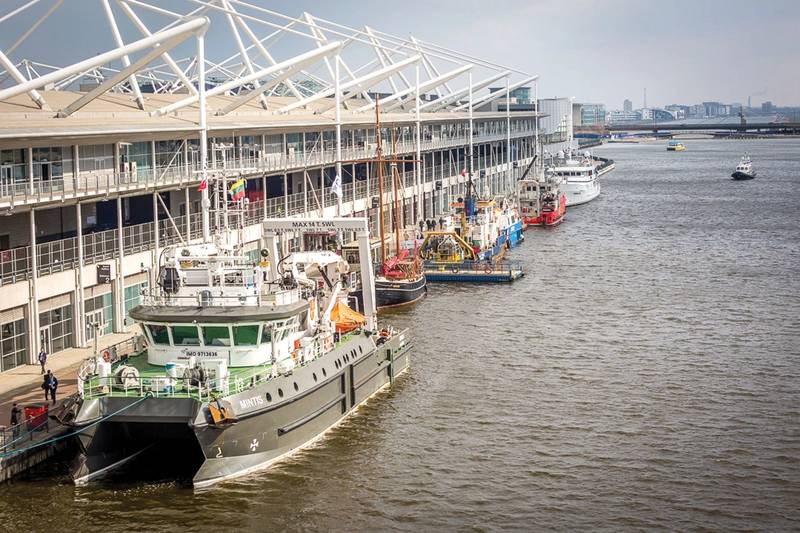 Oceanology International in London features an exhibit, a conference as well as live technology demonstrations on vessels docked outside of the exhibition hall. The next event in London is scheduled for March 2020. Photo: Oceanology International
Oceanology International in London features an exhibit, a conference as well as live technology demonstrations on vessels docked outside of the exhibition hall. The next event in London is scheduled for March 2020. Photo: Oceanology International
When I started, everything was made with valves and vacuum tubes and single transistors. Now, everything is digital. The whole microprocessor world happened. In the 1960s, there were no cell phones, no internet, no Google. Anything you wanted to do was harder.”
Now there are autonomous vehicle swarms that are being used for search operations, such as for the lost Argentinian submarine. “That’s exciting. We’re starting to get to the point where you can work from home and put something in the river and it will be going around the world and you will follow it on your phone and anyone can follow it on their phone,” he says. “That world is happening and it’s very exciting.”
The next step is the use of emergent autonomous systems. “That’s the revolution we are going through at the moment,” says Rayner. “The Xprize is using completely autonomous systems, shore launched and able to do pretty much anything you want without any intervention. Another change is coming – high data-rate communications over the ocean,” he says. “This will open up low-cost high data on the surface of the ocean.”
A lot has changed in the 50 years since Oceanology started. For a start, the liberal cigar and cigarette smoking seen at the early shows is no longer permitted inside conferences. Ocean science instruments are now far more precise, portable and increasingly autonomous.
“Some things haven’t changed much at all,” says Klein. “I was involved in the bathyscaphe Trieste. Before the 1960s it dove down seven miles into the Mariana Trench. To this day, it’s (diving to such depths) not been done again. Right this minute, there isn’t a submarine that can go seven miles down. Ships no longer roll like they did and they know where they are, but being at sea is still hard, it’s still dangerous and tricky. People are making cables with all sorts of exotic materials, with fiber in, but they are still making them using techniques that go back to rope making.”
A theme that has run throughout the past 50 years of Oceanology has been how to make use of the seas and ocean’s in a balanced way. Today, that’s also increasingly tied with managing the earth’s climate.
“The ocean is part of the climate discussion,” says Rayner. “We have seen a revolution of understanding in the way the ocean drives the climate and we will see a lot more understanding of that and operational use of that understanding in the coming decade. We are just starting to see ocean observing becoming used for real in weather forecasting, which wasn’t possible before due to constraints in computing capacity. Data, communications, computing, all coming together.”
There’s also a new push, that of a concern for sustainability and “not trashing the oceans any more than we have and that’s going to drive a lot of new technology,” says Rayner. The “war on plastics” is helping to raise public awareness here. “We cannot avoid the need to exploit ocean resources,” says Rayner. “The challenge is to do it in a way that’s in some sense sustainable.”
Perhaps in another 50 years the same question will be asked of resource exploitation on other planets, for, in the present day, there are also new frontiers. The Catch the Next Wave focus this year is very forward looking: how technology can help explore the oceans of places like Jupiter’s largest moon. “These systems will need to be massively autonomous and mostly below ice,” says Rayner. “That, and work on the sensors that will go on to these devices, is work that is going on right now. It’s a major driver for innovation.”
Klein is confident the industry will rise to the challenge: “There are still some breakthroughs to be made. It’s still very hard to transmit high bandwidth data through water. But I’m optimistic. There’s still huge potential.”



